Blog
Reflections from COP26
We contacted Alison as we felt that the voice of a Penwith resident on the ground at COP26 would be an invaluable addition to the Penwith Futures Book project. As Alison journeyed north, and during her time on the ground in Glasgow, she kindly shared daily photos and diary entries with us to paint a picture of how it felt to be part of this pivotal moment in history.
Alison will be contributing to the Penwith Futures Book which you will be able to read in a year’s time. In the meantime, we thought we would share excerpts from her daily thoughts live from COP26. Perhaps they might inspire you to reflect upon COP26 and the changes you hope to see here in Penwith. And to think about your ideas for the future and get creative in your entries to the Penwith Futures Book.
30th October
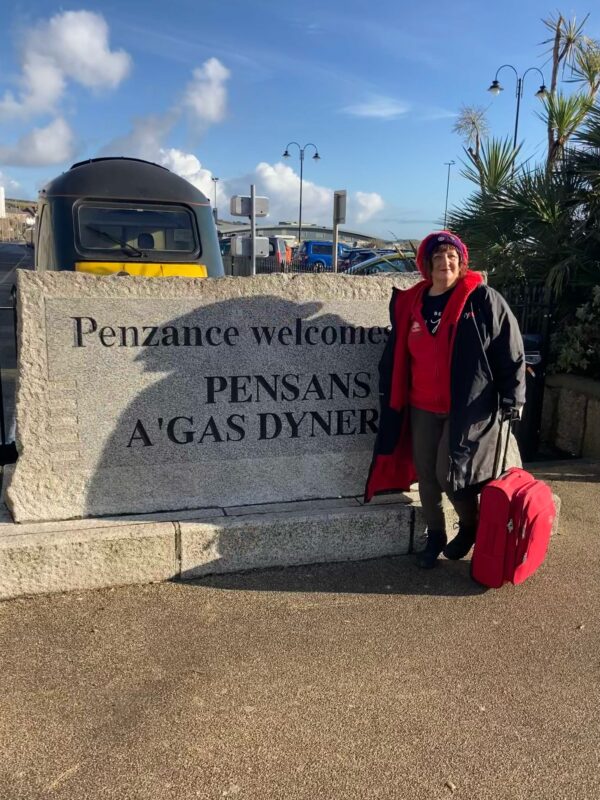
“I am embarking on a 560-mile train journey to Glasgow with my case crammed full of banners, flags and thermals. Leaving balmy Penzance, dressed for comfort rather than style, I am overheating. Glasgow is significantly colder and I’ve been advised to prepare for wet weather. On the train my phone is constantly showing new messages with requests for people to join marches, prayer vigils, actions and visit art events. This feels like a holiday but I know there is a serious purpose. I am going to COP26 to bear witness to the climate emergency. I am driven to be there to show the world leaders and decision makers that individuals, the worker ants, demand real action with commitments to limit global temperature rise to 1.5°C. They are accountable to us and our future generations.”
31st October
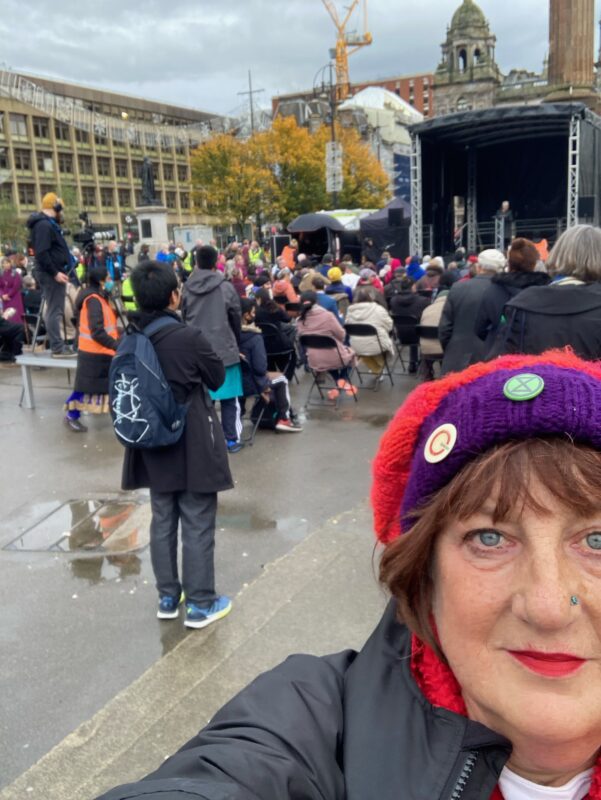
“I walk on the pedestrianised grid of streets orientating myself in this unknown city. I notice a few activists, recognisable by their rucksacks and badges. There is a large interfaith vigil with representatives leading prayers and meditations for those making decisions at COP26.
Glasgow Quaker Meeting House is providing a space to mentally and physically replenish oneself. I join a FWCC (Friends World Committee for Consultation) event hosted by Quakers in Glasgow.
Quakers from around the world share what is happening in their countries with the climate emergency and their hopes for the future. The Quaker from the Philippines speaks of the need for the world leaders at COP26 to listen to the scientists, to follow the science and stop blaming individuals, rather than the fossil fuel companies, for the dangerous position the earth is in.
I stay for the early evening reflection which steadies and calms my thoughts.”
31st November
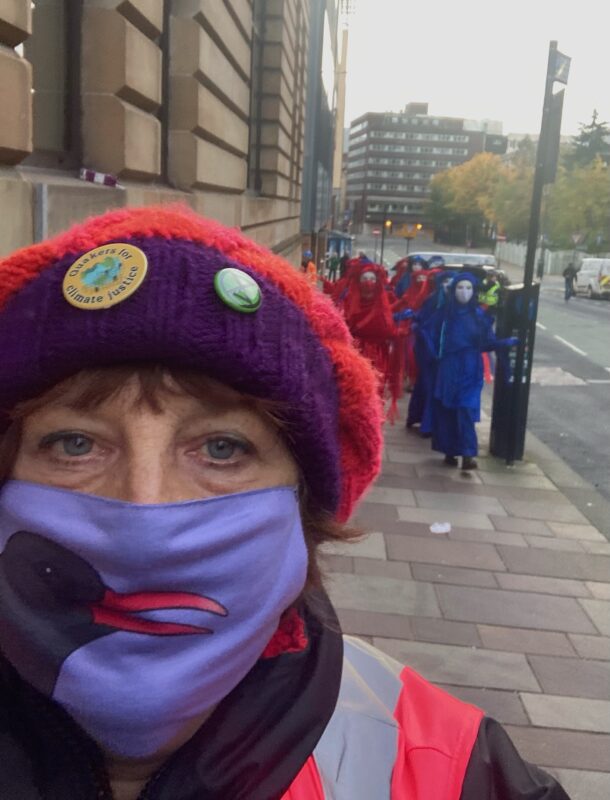
“The Red Rebels are arriving. These enigmatic figures appear without warning, moving silently among humanity.
“Red Rebel Brigade symbolises the common blood we share with all species,
That unifies us and makes us one.
As such we move as one, act as one and more importantly feel as one.
We are unity and we empathise with our surroundings, we are forgiving
We are sympathetic and humble, compassionate and understanding,
We divert, distract, delight and inspire the people who watch us,
We illuminate the magic realm beneath the surface of all things and we invite people to enter in, we make a bubble and calm the storm, we are peace in the midst of war.
We are who the people have forgotten to be!”
I am asked to help steward to keep performers safe and to ensure clear pathways for the public when in crowded places. We walk to a meeting point and the Red Rebels, accompanied by the Scottish Blue Rebels, glide out onto the pavement. Slowly, with purpose, the Red and Blue figures advance along the pavements, looking neither left or right accompanied by a single drummer. They advance with the stewards skittering around them to clear pathways, halt traffic and reassure police
Somehow the media is awakened and camera crews appear eager to film and photograph the Red and Blue tableau as they reach Glasgow Central station. Without warning the figures regroup and glide to a new resting place. And move again. Like a restless but slow-moving sloth. All the while the insistent rhythm of the drum sounds throughout the building.
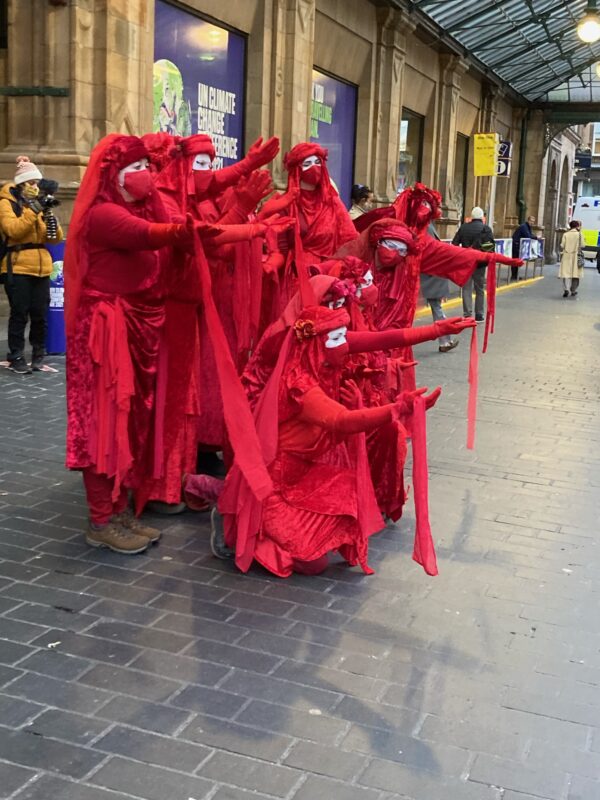
At a signal we stewards are sent off to meet the Euston train. Emerging from the crowd of travellers is a second group of Red Rebels making their stately way to the main concourse. We scurry ahead to clear a path and the 2 groups meet, create new arrangements and then without a sound turn and retrace their steps out of the station.
What an experience.”
5th November
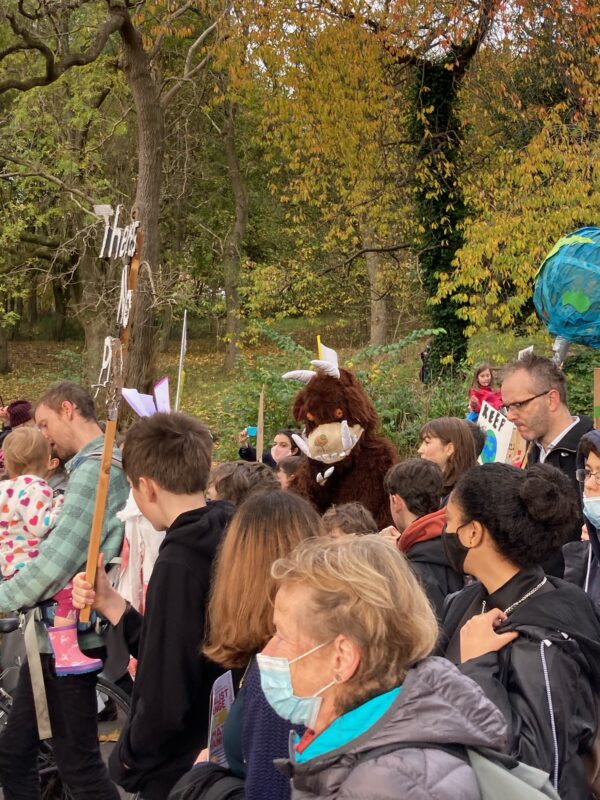
“This is the young adults and children’s march Fridays For Future and Extinction Rebellion are there to support them.
Three of us take the subway to the centre of Glasgow. We are met by the stage manager who needs three people to stand by the barriers to monitor who is coming in and out of the backstage area.
Delegates begin to arrive. I am not briefed on who is allowed in but a helpful Spanish speaking steward from another activist group works with me. I defer to him as it is a Fridays For Future event, not Extinction Rebellion. Another steward joins us and we share biscuits and climate activism stories. We muddle through with a lovely Glaswegian man who came to find out what the fuss was about and ended up staying for the whole event, moving the metal fence open and shut as needed.
We hear the march arriving before we see anyone. The samba band is playing, rhythms that enthuse, inspire, call to the soul. A sea of flags and placards advances and the square fills. Climate activists from around the world including, Ayidha Saddiqa, Chris Mitchel, Mikaela Loach, Sofia Gutierrez, Vanessa Nakate and Greta Thunberg speak calling on global governments to commit to real climate action. And then it is over. Greta Thunberg is whisked away and I say goodbye to my new friends; the Glaswegian, the Spanish speaking steward and the student from Preston who travelled up for the day to join the march.”
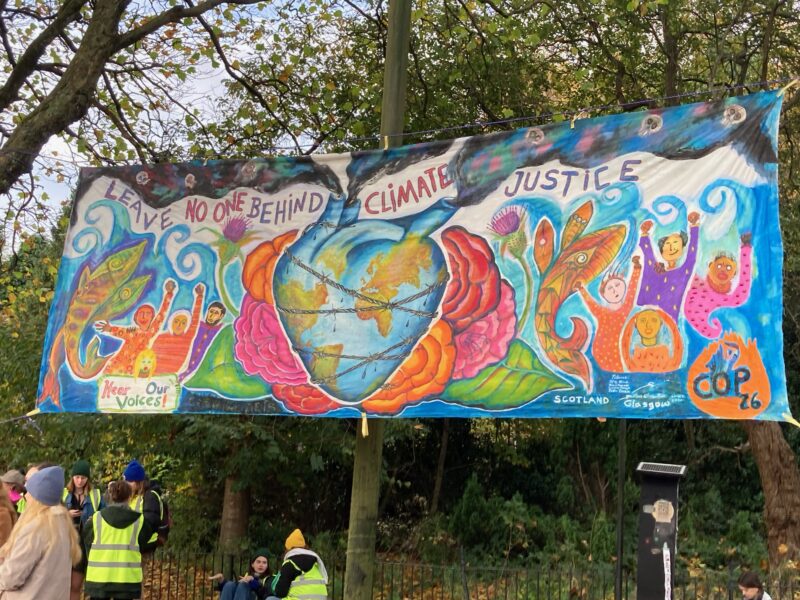
Our House – the story of Morrab House 1841 – 1900.
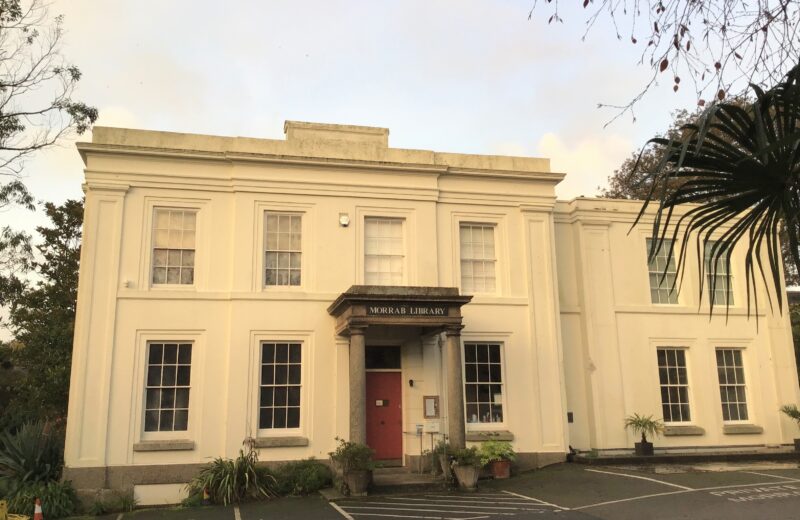
Among the many fascinating items displayed inside the Morrab Library is a bill of sale dated 1887, detailing the accommodation offered at Morrab House. Some of the rooms and stairways are easy to identify, some not, and there seems to have been a certain amount of double counting with regard to bed and dressing rooms… but hey, that’s the property business.
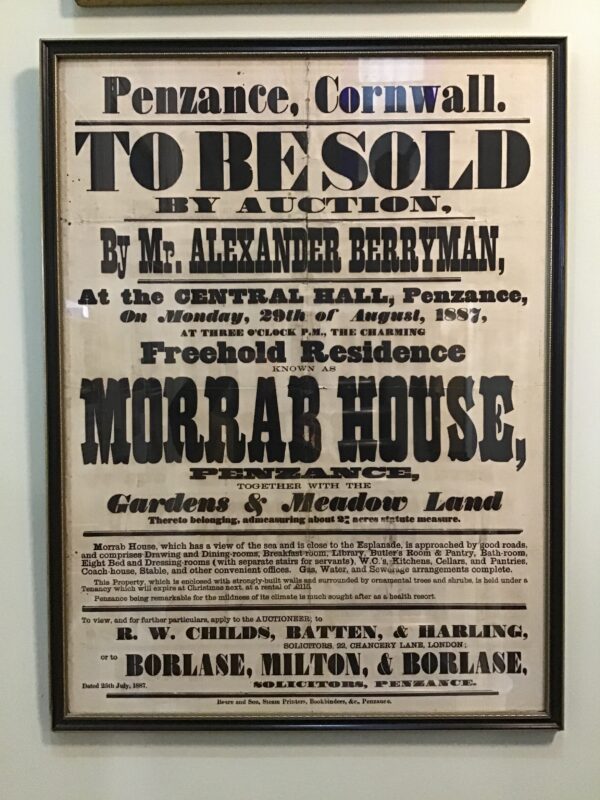
This was the building and land that would later be purchased by Penzance Town Council, keen to establish a garden for the pleasure of residents and the better class of tourist – and in the process acquiring the house, more or less by accident.
The original owner, Samuel Pidwell, had been a notable man. Educated at Oxford, in his youth he had made an early ascent – the 17th – of Mont Blanc. Back in Penzance, he married his cousin Ann Batten. The couple, two children (four more would follow later), Ann’s sister and four servants built themselves a brand new house in Morrab Fields, with a clear view out into the Bay and westwards to Penlee Point. Samuel Pidwell, although describing himself as a brewer, had considerable investments in mining. Before his death in 1854, aged only 46, he served twice as mayor, and was prominent in the Royal Geological Society of Cornwall.
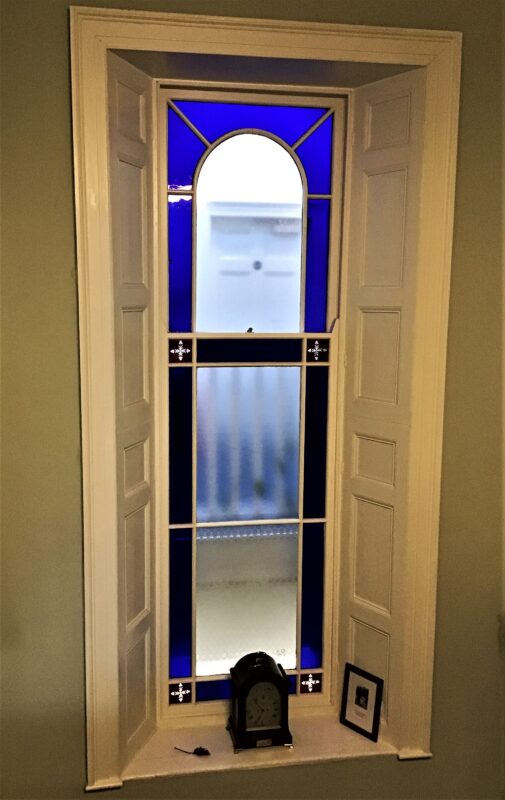
Later, the house was owned by Charles Ross. 150 years on, he is known principally for the bridge that still bears his name, and his supporters would point to the development of Morrab Road as further evidence of his goodwill and forward thinking. But in his own time, Charles Ross had other claims to fame: as the developer of Newlyn harbour, thereafter as the Conservative MP for St Ives constituency, and finally – in 1896 – for misjudgements that led to the spectacular collapse of the Batten, Carne and Carne Bank.
And so the Corporation acquired – at a cost of £3,120 – a fine building and surrounding land. The Town Council enthusiastically set about developing the grounds, but decided that the house should be leased out. The YMCA – at this date, identified with education and the promotion of wholesome living rather than housing provision – was the only formal bidder. “It is hardly likely that a better tenant will come forward,” the Cornish Telegraph suggested, while acknowledging that the Penzance Library – then housed in the Public Buildings, now St John’s Hall – might still be on the lookout for a new home. “We shall see,” the newspaper added darkly, “what we shall see.” Sure enough, a bid from the Library arrived in due course, and although their offer was almost identical to the YMCA’s, it was the Library’s bid that was accepted.
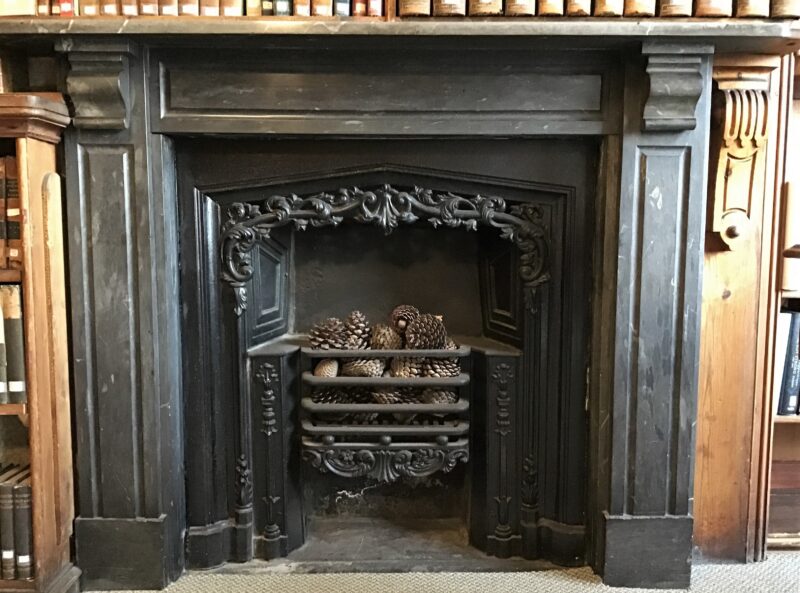
Not everyone, however, was happy with the decision. There were objections about carriages driving through the Gardens (YMCA clients would presumably have arrived on foot or bicycle), and the perceived exclusiveness of the Library. A letter to the Cornish Telegraph later referred to “the ‘class’ legislation which installed a lot of wealthy people in Morrab House.
The Library moved to its new premises in August 1889. The Cornishman reported that “a number of members seemed unwilling to say goodbye” to the old St John’s Hall rooms, and “lingered an hour after closing time.” Anxiety about fire from theatrical shows had prompted their move, and this was not left entirely behind. On the fine September evening when an evening illumination provided a finale for the official opening of the new Gardens, Morrab House remained “shrouded in darkness, the one dismal spot” on account of the Library staff, and “that haunting dread which has driven them from their old home [and] seems to hang over them still.”
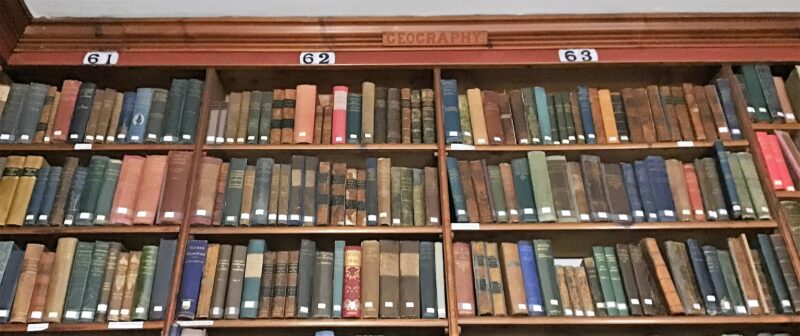
Despite this gloom, floor to ceiling shelves were constructed in most of the rooms. Most of these survive today, as do many of the original fittings throughout the house. You can still glimpse some of the Pidwell’s wallpaper on the walls behind the shelves, admire the marble fireplaces and the rose cornices on the ceiling, and still feel as though you are sitting in a beautiful family home.
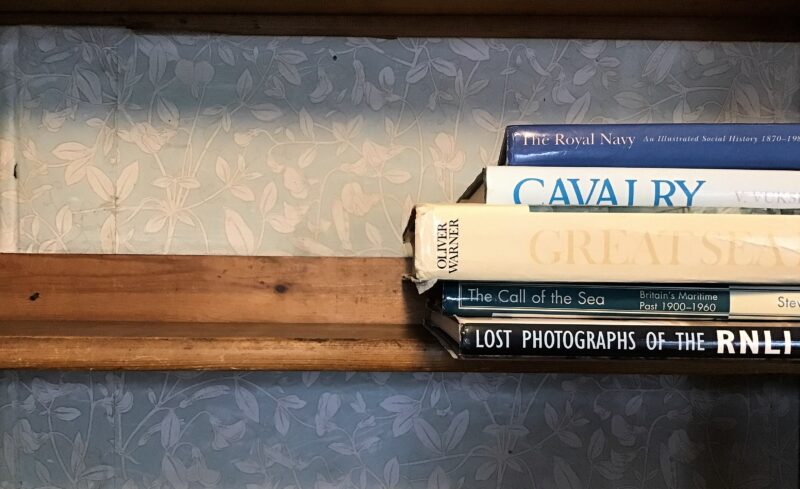
But the real problem at the spacious new premises in 1889 was that the rooms had to be filled. William Bolitho of Ponsandane came forward with a substantial bequest, to be spent on books costing at least two guineas each. Other major bequests and donations followed, perhaps the most significant donor – certainly in terms of volume – being the 1911 bequest of Prebendary Philip Hedgeland, Vicar of St Mary’s Church. Pick books from the shelves in any room – science, literature, classical or modern languages – and you are likely to find that they once belonged to him.
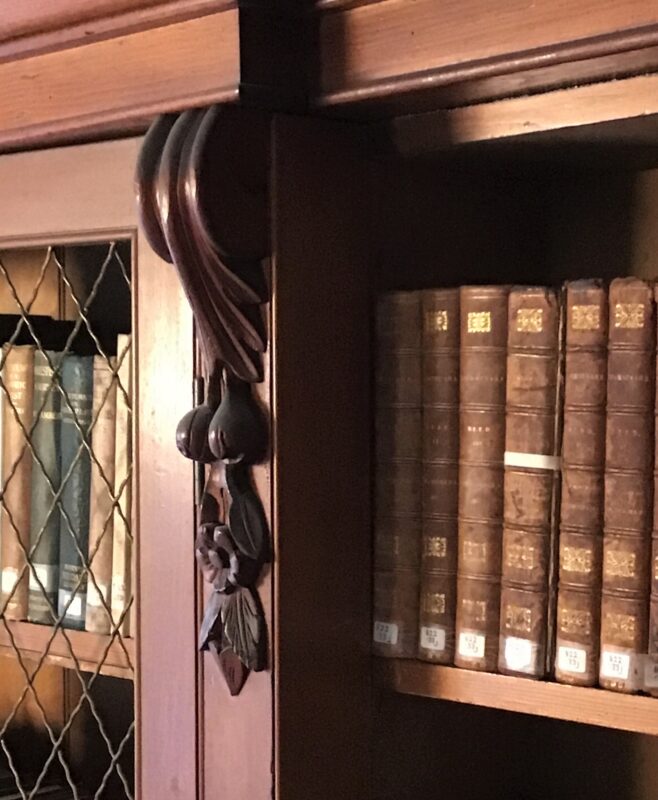
Since then, the Library has certainly had no problem filling its shelves – and although various changes have been made to the building, the original parts remain very much the same as they were in 1889. Lights and other fittings have been updated as times have changed, carpets have been laid (and taken back up again to reveal the wooden floors), wallpaper has been pasted on (and painted over) – and the books have migrated from shelf to shelf and from room to room; but Morrab Library’s quintessential essence remains. Even the major extension to the building in 2013, now housing our art room and Photographic Archive, served to only enhance this remarkable space: Samuel Pidwell’s Morrab House of 1841.
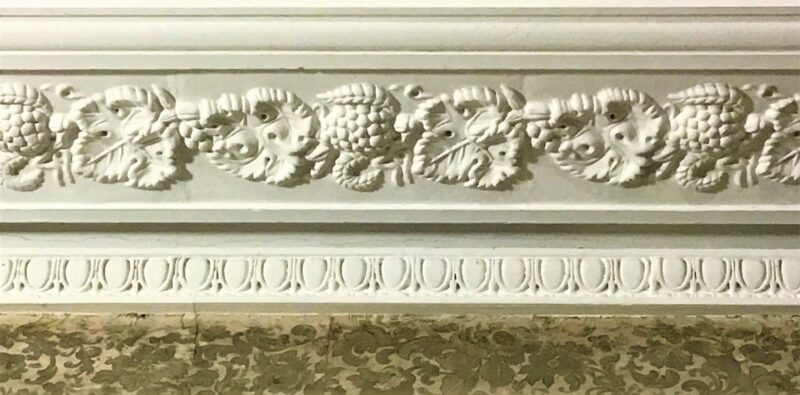
Perhaps the best way to end this blog is to quote the quintessential local author Arthur Quiller Couch:
‘There are hundreds of bigger and finer libraries, but few have a pleasanter tradition, and not one is so beautifully placed. Can a bookish man imagine anything more delightful than a library put together by the taste and care of generations of scholars and students, and set in a garden?’
We think not, Q; …we think not.
Linda Camidge
December 2021
All about…Fairest Creatures by Karen Taylor – a new thriller
Here’s a new blog from another of our incredibly talented library members, Karen Taylor, who has just published her latest novel – a thriller!
Penzance is the inspiration for my new thriller Fairest Creatures. And the Morrab Library is where I researched, wrote, and edited so much of it.
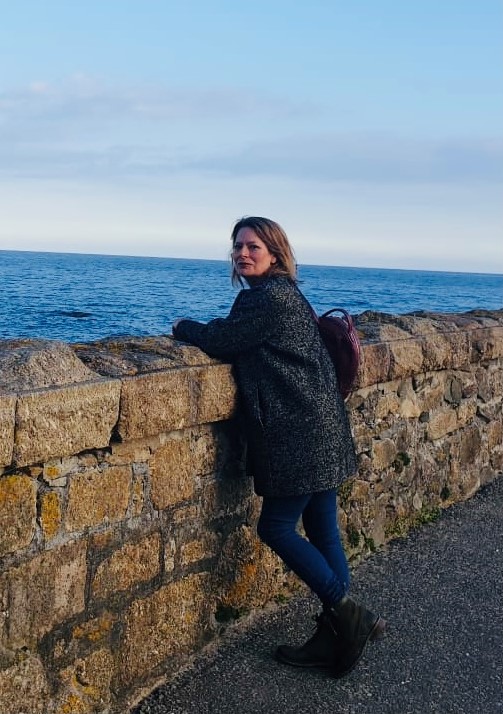
One of the things I learnt on the Creative Writing MA course I went on at the University of East Anglia was how place can be a character. I hope that this comes through in my writing. So many of my ideas were formed on early morning jogs by the sea – and later turned into prose and plot as I hit the keys in my Penzance apartment or in the Literature Room at The Morrab. The library gets a key scene in Dark Arts, the Crime Fiction book I wrote at UEA as my dissertation. But there are so many other places that Cornish readers will recognise in Fairest Creatures – from the Jubilee Pool café, Turks Head and Admiral Benbow to the small, terraced houses lining Bread Street and the panoramic Gurnard’s Head promontory.
Another key inspiration is the art world, so much a part of Cornwall. Although Fairest Creatures is about a serial killer — this is no ordinary predator. He’s someone more interested in wielding a paint brush than a knife. His obsession with the preservation of beauty is his driving force.
I would say that writing the book was one of the easiest parts. It’s a cliché, but once you get into a story and its characters the book almost writes itself. And I had the time. I came up the with the idea in February 2020 on a stormy night in Penzance. I sent the first pages off to the Crime Writers’ Association Debut Dagger competition and, within months, I had been longlisted for the prize, just after the shutters came down on life as we knew it. The first Lockdown. Keys and captivity feature in the book; being locked in my house made writing one of
my only escapes. But all things pass. Restrictions eased, my book found a publisher and I found the perfect local artist to illustrate my cover.
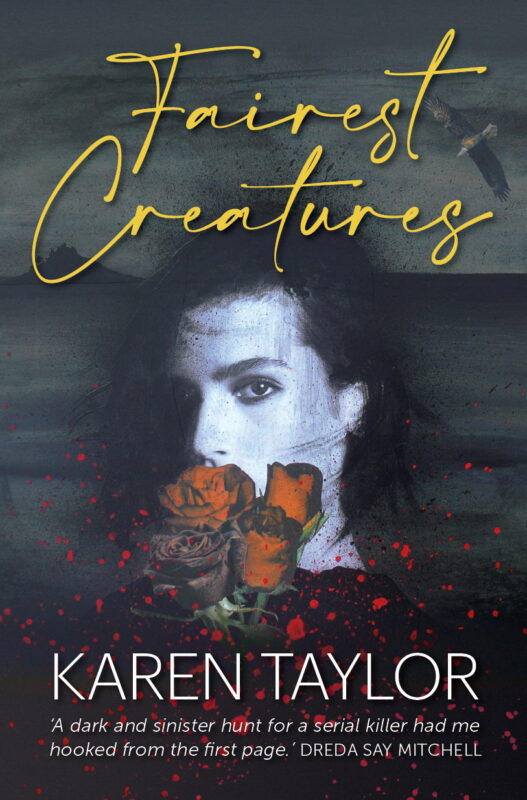
 I knew that the right cover was crucial. My publisher and I had gone through 100s of stock photographs, and we couldn’t agree on any. And then in June this year I went to the Penzance Studios exhibition and discovered Janine Wing. Or, rather, one of her striking portraits caught my eye. The intensity of the look and the mystical style was perfect for a book about art and unknown and sinister forces. Janine agreed to create a new portrait reflecting the book’s central themes.
I knew that the right cover was crucial. My publisher and I had gone through 100s of stock photographs, and we couldn’t agree on any. And then in June this year I went to the Penzance Studios exhibition and discovered Janine Wing. Or, rather, one of her striking portraits caught my eye. The intensity of the look and the mystical style was perfect for a book about art and unknown and sinister forces. Janine agreed to create a new portrait reflecting the book’s central themes.
I have written for a living since my early twenties, as a journalist and editor. But Fairest Creatures realises a lifetime ambition to be a published author. It seemed only right that I would launch the book in Penzance and at the best Library in the whole world.
Fairest Creatures is available to borrow at the library and to buy at independent and major book sellers.
